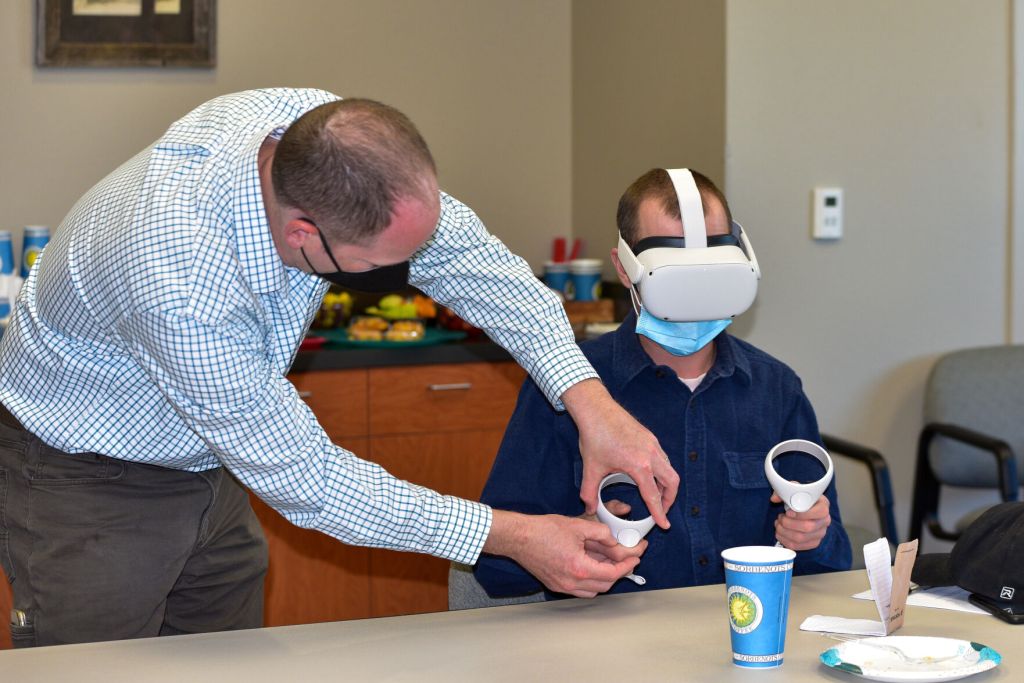OTEC using virtual reality to promote safety
Published 7:00 am Friday, October 22, 2021

- Charlie Tracy, left, director of engineering at Oregon Trail Electric Cooperative, provides guidance to Nick Vora, Union County’s emergency manager, as he tries OTEC’s virtual reality training on Sept. 30, 2021.
LA GRANDE — Oregon Trail Electric Cooperative became the first electric company in the nation to use virtual reality technology to share safety education messages with the public.
Trending
This move helped start a high-tech campaign that today is gaining momentum. The virtual reality videos OTEC produced in 2018 have been so well received that plans are being made to produce more in the future, according to Joe Hathaway, the cooperative’s communications coordinator.
“We are trying to take our education a step further,” he said.
Plans will soon be developed, Hathaway said, to produce additional virtual reality videos about electrical power safety at home, in the workplace and in other venues. These will complement the two virtual reality safety videos OTEC has already produced to educate first responders about how to protect themselves when in the presence of fallen electrical lines and another aimed at helping farmers to work more safely when in the presence of power lines.
Trending
La Grande Police Chief Gary Bell said the virtual reality videos for first responders are valuable in helping law enforcement officers learn how to better work safely around downed power lines.
“I commend OTEC for using technology to show how to respond to hazardous situations,” he said.
Bell said law enforcement officers are often the first to arrive at the scene of live electrical lines that have been thrown to the ground by strong winds or after a motorist has crashed into a power pole.
“We encounter down power lines with a lot more frequency than people are aware of,” he said.
Nick Vora, emergency manager for Union County and a La Grande Rural Fire Department firefighter, also said he is impressed with the work OTEC has done to create the safety videos.
“The downed power line training videos that OTEC has developed really demonstrate its commitment to ensuring the overall safety of the communities they serve,” he said.
Vora said virtual reality videos make it possible to focus more on what is being taught.
“After experiencing it, I think the immersive nature of VR video is a great format for delivering video-based training, because distractions are all but eliminated, and as a result, I expect content retention will be much higher compared to other remote and self-paced learning methods,” he said.
Vora also said virtual reality training addresses an important need because many first responders are volunteers who work diverse hours.
“The VR headset training is an effective conduit to deliver consistent training to first responders who may have difficulty finding time to attend traditional classroom-based training,” he said. “This is especially relevant for agencies staffed by volunteers with varying work and life schedules.”
Anyone putting on a headset takes a dive into the world of immersive technology. The 360-degree video engages the viewer in 3D fashion.
When participants put on a headset, they can look up, down and 360 degrees around a scene while they listen to the training, allowing OTEC to communicate safety messages with greater nuance and more impact, Hathaway said.
The VR video on agricultural safety encourages farmworkers to conduct a hazard assessment prior to working so they know the placement of power lines.
OTEC’s safety advice is to stay at least 50 feet between a farm implement and a power line, which may require spotters to alert the equipment operator.
Farmers who are irrigating are asked to locate electrical hazards prior to starting work and keeping equipment and metal pipes at least 50 feet away from power lines.
Hathaway noted that agricultural equipment is usually tall, increasing the likelihood that someone operating it could hit an overhead power line. This is why one of the pieces of advice to agricultural workers on the video is “Look up to live.”
Hathaway believes virtual reality training will be a big part of OTEC’s educational tool kit for years to come.
“Virtual reality is the wave of the future. It will play an active role in our safety program,” he said.
The videos for first responder and agriculture workers are among seven OTEC has made. The five others focus on tourism and economic development in Northeastern Oregon. The tourism videos were made because OTEC wants to bolster the economies of the counties it provides service for.
“We want to boost tourism because it can drive the economy,” Hathaway said.
The Golden Shovel Agency of Minnesota produced OTEC’s seven virtual reality videos, and production of the videos was sponsored by Federated Rural Electric Insurance.
OTEC’s VR videos can be seen on its website, www.otec.coop. People interested in having safety presentations using the virtual reality headsets should call OTEC in La Grande at 541-963-3115 or in Baker City at 541-523-3743.









